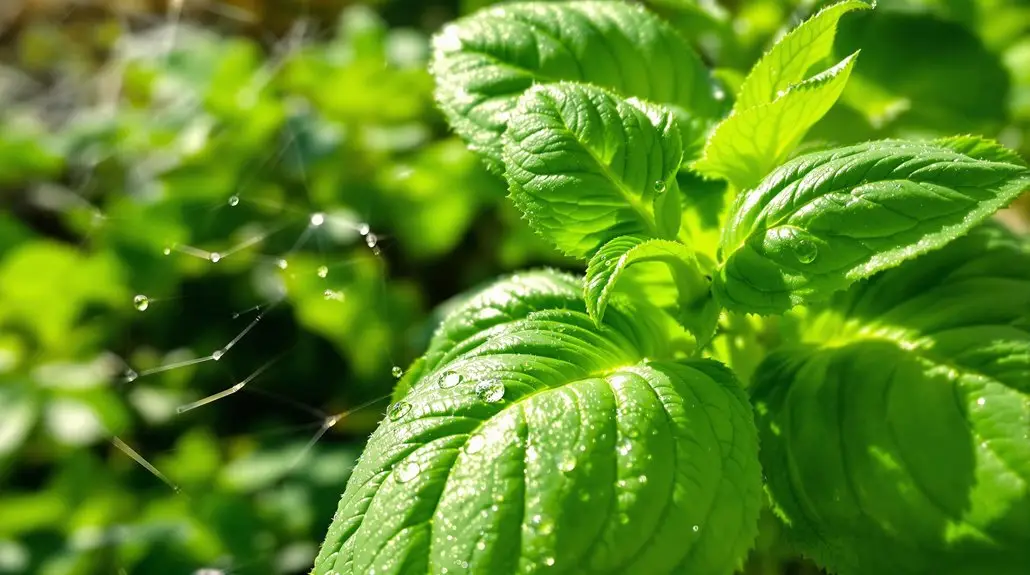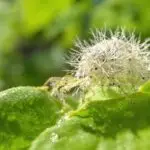Essential oil of Basil (Lamiaceae Ocimum basilicum) is packed with potent pesticidal compounds like linalool, methyl chavicol, and eugenol. These components make it effective against many pests, including dust mites, stored product insects, and mosquito larvae. With oil formulations achieving up to 100% mortality in specific conditions, basil serves as a viable eco-friendly alternative to synthetic pesticides. You can find impressive results, where 3-4% concentrations eliminate 97-100% of dust mites. Plus, the activity isn’t just limited to killing; it alters pest behavior too. If you’re curious about its broader applications and advantages, there’s plenty more to uncover.
Key Insights
- Basil (*Ocimum basilicum*) contains active compounds like linalool and methyl chavicol, crucial for its pesticidal effects.
- Basil oil formulations achieve 97-100% mortality against pests, including dust mites, at concentrations of 3-4%.
- Its essential oil exhibits high toxicity against insects, outperforming conventional acaricides and significantly reducing egg viability.
- Basil extracts effectively target mosquito larvae, causing rapid mortality and morphological changes within 14 hours.
- The eco-friendly nature of basil’s pesticidal properties promotes sustainable pest management and reduces reliance on synthetic pesticides.
Pesticidal Components of Basil
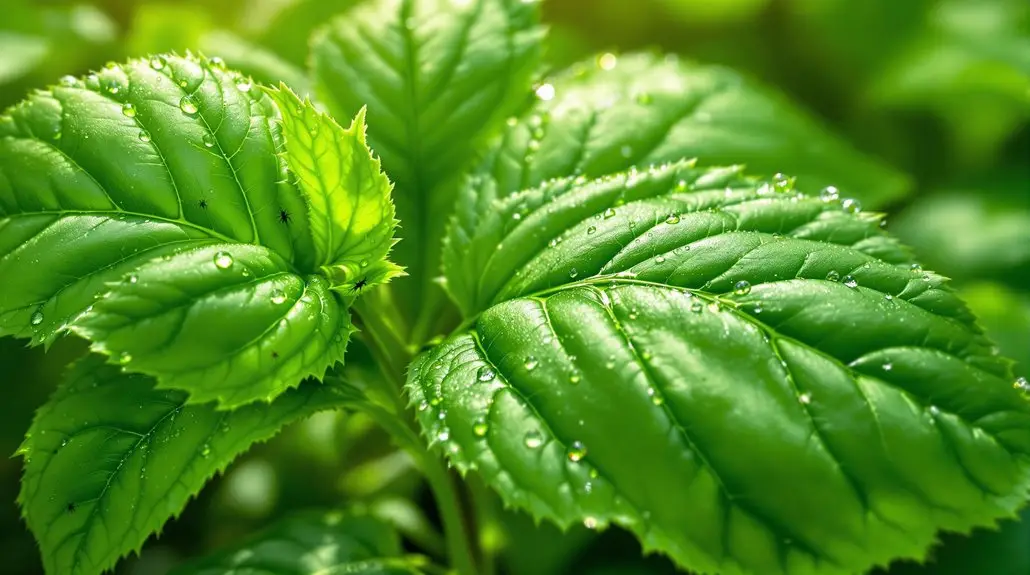
When it comes to the pesticidal components of basil, you’ll find a range of active compounds that work effectively against various pests. One of the standout players is 1,8-Cineole, known for its impressive larvicidal activity. But that’s not all—methyl chavicol plays a major role, though it isn’t the only active larvicidal compound in basil. Linalool, another key component, offers both repellent and toxic effects, making it valuable in pest control. Then there’s terpinene, a monoterpenoid that enhances the insecticidal properties of basil, along with estragole, which also boasts insecticidal properties. Basil oil formulations are particularly effective, achieving a staggering 97-100% mortality rate against pests like dust mites at just 3-4% concentrations. You’ll also find that basil essential oil can wipe out pests like Sitophilus oryzae with 100% mortality recorded after 48 hours at 6 mg/cm². If you’re dealing with mosquitoes, basil extracts have shown effective LC50 values against Ae. albopictus, providing a natural solution. Additionally, the chemical composition of sweet basil includes various insecticidal compounds, such as methyl cinnamate and eugenol, further enhancing its efficacy in pest management. With these components, you can harness the power of basil not just for cooking, but for practical pest control too. The natural insecticidal and repellent properties of basil make it an excellent choice for anyone looking to reduce reliance on synthetic pesticides, while also being part of a community that values eco-friendly solutions. Recent studies have shown that basil essential oils exhibit significant mortality rates against Sitophilus oryzae, reinforcing their potential as natural insecticides. Moreover, these properties align with the growing trend towards natural and organic pest control solutions, highlighting the importance of sustainable practices in pest management.
Acaricidal Activity Against Dust Mites
Basil’s pesticidal components aren’t just limited to insect control; they also exhibit significant acaricidal activity against dust mites. If you’re looking for a natural way to tackle these annoying allergens, basil oil might just be your new best friend. Here’s why it’s worth considering:
- Active Principles: Citral, alpha-terpineol, and linalool are powerful compounds found in basil oil.
- High Toxicity: Citral and menthol show higher toxicity levels than conventional acaricides, making them effective in smaller amounts.
- Impressive Efficacy: Spraying basil oil at just 3% or 4% concentration can lead to 97% to 100% mortality of dust mites.
- Vapor Action: The vapor from basil oil increases its effectiveness, especially in closed environments. Recent studies have shown that basil oil’s major constituents like citral can achieve significant mortality rates in dust mites.
- Practical Application: You can easily dilute basil oil in water or alcohol and spray it on surfaces frequented by dust mites. Additionally, studies have shown that basil oil’s constituents like citral can achieve significant mortality rates in dust mites.
Using basil oil not only provides a natural solution for dust mite control but also aligns with a growing desire for eco-friendly practices in your home.
Just remember to let surfaces rest for an hour after spraying before vacuuming to remove any dead mites.
With the potential for commercial formulations on the horizon, embracing basil oil can be a step toward healthier indoor air quality.
Insecticidal Effects on Stored Pests
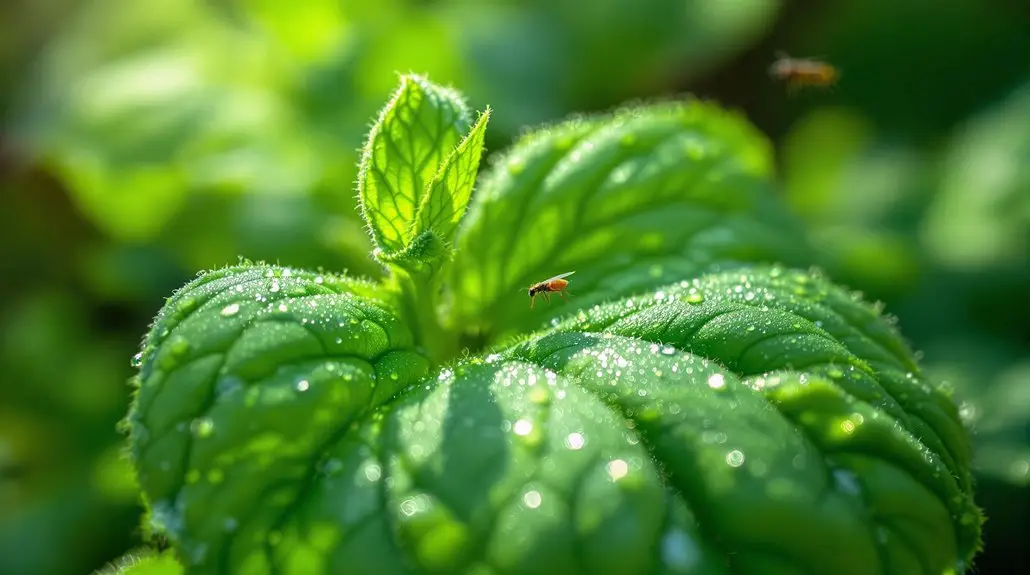
Stored pests can wreak havoc on your food supplies, but basil oil offers a potent solution for controlling these invaders. When it comes to stored product pests like adult moths, basil oil demonstrates impressive efficacy. You’ll find that it achieves over 80% mortality at low doses, making it a reliable choice for pest management. Not only does it impact adult moths, but it also greatly reduces egg viability, with mortality rates ranging from 73% to 79%.
While larvae and pupae are more tolerant to basil oil, with larval mortality peaking at just 21%, the oil’s effectiveness remains remarkable. The dose-response relationship indicates that small increases in concentration can lead to dramatically higher mortality rates. Major constituents like linalool, estragole, and trans-anethole play essential roles in this insecticidal activity, ensuring that each application can target pests efficiently. Additionally, studies have shown that basil oil achieves lethal times for 90% mortality (LT90) ranging from 8 to 38 minutes, underscoring its rapid effectiveness. Recent research has highlighted the essential oils from basil as effective against stored-product insects, confirming its role in pest management. Furthermore, using eco-friendly methods in pest control can enhance the effectiveness of treatments like basil oil.
Basil oil’s fumigant properties also add to its versatility, allowing you to combat various pests, including troublesome fruit flies. You’ll appreciate its species-specific action, as different pests respond uniquely to the main components. For instance, estragole acts more swiftly against certain flies, highlighting the importance of knowing your pest’s developmental stage.
Ultimately, incorporating basil oil into your pest control strategy not only helps protect your stored food but also aligns with a more natural approach to pest management. Embracing this method fosters a sense of community, as you join others in seeking effective, eco-friendly solutions.
Larvicidal Activity Against Mosquitoes
Harnessing the power of basil can be an effective strategy for tackling mosquito larvae, as various extracts from the plant showcase significant larvicidal activity. This natural approach not only helps in managing mosquito populations but also promotes environmental security.
Here are some key points about basil’s larvicidal effects:
- Target Specificity: Extracts effectively target several mosquito species, including *Anopheles arabiensis* and *Culex quinquefasciatus*.
- Biochemical Changes: Ethanol extracts lead to noticeable morphological changes in larvae, causing deformities and affecting their behavior.
- Rapid Action: You can observe changes in larval behavior within 20 minutes of treatment, with eventual mortality occurring within 14 hours.
- Extract Potency: Ethanolic and hexane extracts outperform water extracts, with flowers showing higher potency than leaves. Additionally, basil can serve as a cost-effective DIY solution for natural insect repellent preparation.
- Eco-Friendly Option: Basil oil stands out as a natural alternative to chemical pesticides, promoting a more secure environment for both humans and non-target organisms. Furthermore, the presence of bioactive compounds in essential oils contributes to the observed larvicidal activity against mosquito larvae, including *Aedes aegypti*.
Chemical Composition of Basil Oil

When you explore the chemical composition of basil oil, you’ll find that its major constituents vary considerably among different basil varieties. For instance, *O. basilicum var. purpureum* is rich in methyl-chavicol, while *O. basilicum var. thyrsiflora* boasts a high linalool content. Understanding these terpenes and their roles can help you appreciate the oil’s unique properties and potential applications. This variation in chemical profiles emphasizes the importance of cultivar selection in maximizing the benefits of basil oil. Additionally, the high linalool content in certain varieties is believed to repel insects, further enhancing their practical applications.
Major Chemical Components
Basil oil boasts a complex array of major chemical components that contribute to its unique properties and applications. You’ll find that these compounds not only enhance the oil’s fragrance but also provide potential health benefits.
Here are some key components that stand out:
- Linalool: The primary constituent, making up 45-62% of the oil.
- Methyl chavicol: Present in varying amounts, from trace to 30%.
- Eugenol: A significant player, found in concentrations of 2-15%.
- Terpenoids: This group includes various essential oil constituents.
- Antioxidants: Compounds like caffeic acid and quercetin contribute to health benefits.
These major chemical components work synergistically to give basil oil its stimulating, purifying, and anti-microbial properties. Notably, the essential oil quality can vary based on growing conditions, which highlights the importance of environmental factors in determining the effectiveness of basil oil. Additionally, basil oil is primarily extracted from the leaves of Ocimum basilicum, ensuring that the most potent parts of the plant are utilized for its essential oil.
The pale-yellow liquid, with its floral and spicy aroma, not only elevates your culinary creations but also holds promise in various applications, including pest control.
Understanding these components can deepen your appreciation for basil oil and its potential, making it a valuable addition to your home and health toolkit.
Comparative Oil Composition
The chemical composition of basil oil varies considerably across different cultivars and regions, influencing its characteristics and uses. You’ll find that major components like methyl chavicol, linalool, and eugenol are common in various basil species. For instance, *O. basilicum var. purpureum* is rich in methyl chavicol, while *O. basilicum var. thyrsiflora* boasts a high linalool content. If you’re exploring lemon basil, you’ll discover that it primarily contains citral and nerol, setting it apart from other varieties. Regional differences play a significant role too. European basils tend to focus on linalool and methyl chavicol, whereas tropical varieties often contain methyl cinnamate. Additionally, you might encounter *O. minimum*, which features geranyl acetate and terpinen-4-ol. Environmental and genetic factors can also influence the composition of basil oil, so it’s essential to take into account cultivation conditions. Notably, the aromatic profile of basil oil is also enhanced by its variety of beneficial properties, making it popular for both culinary and therapeutic uses. Furthermore, the increasing demand from the pharmaceutical sector is contributing to the growth of the basil oil market. When extracting basil oil, methods like hydrodistillation and supercritical fluid extraction yield varying results, affecting the oil’s purity and composition. This variety in chemical makeup not only defines the oil’s aroma and flavor but also its potential applications in fields ranging from culinary to medicinal.
Terpenes and Their Roles
Understanding the role of terpenes in basil oil can truly enhance your appreciation for this versatile herb. These aromatic compounds not only contribute to basil’s distinct scent but also provide a range of beneficial properties that you might find fascinating.
Here are some key terpenes found in basil oil:
- α-Pinene: Adds a pine-like aroma, reminiscent of fresh forests.
- Linalool: Offers floral and herbal notes, creating a calming effect.
- Ocimene: Gives basil its unique and invigorating aroma.
- Borneol: Imparts a camphor-like scent, adding complexity.
- β-Pinene: Similar to α-pinene, enhancing the pine fragrance.
These terpenes play essential roles in basil’s functionality:
- Antimicrobial Activity: They help combat bacteria and fungi.
- Insecticidal Effects: Effective against pests, making basil a natural pesticide. Additionally, Tulsi (Holy Basil) is known for its cultural significance as a sacred plant in India.
- Antioxidant Activity: Protects cells from oxidative stress.
- Immune Modulation: Some terpenes can support immune health.
- Stress Reduction: Holy basil’s terpenes may help lower stress levels. Additionally, understanding the importance of terpenes can enhance your knowledge of how they influence various plant properties.
Embracing these aspects of basil can deepen your bond with this herb, making it more than just a culinary delight.
Efficacy of Basil Oil Formulations
Essential to pest management, basil oil formulations demonstrate significant efficacy against various insect pests and acarids. You’ll find that these natural solutions can effectively combat common pests, making them an appealing choice for those seeking more secure alternatives.
For instance, basil oil shows 100% mortality against the rice weevil (*Sitophilus oryzae*) at just 6 mg/cm² after 48 hours. Similarly, with *Callosobruchus maculatus*, the oil exhibits a dose-dependent response, with an LC50 of 1.79 μL/L and an impressive LC95 of 4.36 μL/L.
Not only does basil oil kill pests, but it also acts as a fast repellent, achieving 61.2% repellence against *S. oryzae* within an hour at 0.75 mg/cm². This rapid action makes it an excellent option for immediate pest control. Additionally, the use of essential oils has been shown to mitigate risks associated with chemical insecticides in agriculture, enhancing food safety. Moreover, companies like NaturePest emphasize the importance of organic pest control methods, which align with the use of such natural solutions.
When it comes to acarids like *Dermatophagoides farinae*, sprays of 3% and 4% basil oil yield up to 100% mortality, outperforming traditional chemicals like permethrin. The application of essential oils as a natural insecticide presents an eco-friendly alternative for pest management.
The versatility of basil oil formulations extends beyond agricultural use; they’re also suitable for indoor environments, effectively managing dust mites.
As you explore these natural alternatives, consider how basil oil can serve as a sustainable option for pest control. With potential applications in both agriculture and home settings, incorporating basil oil into your pest management strategy could foster a healthier environment for everyone.
Comparison With Synthetic Pesticides
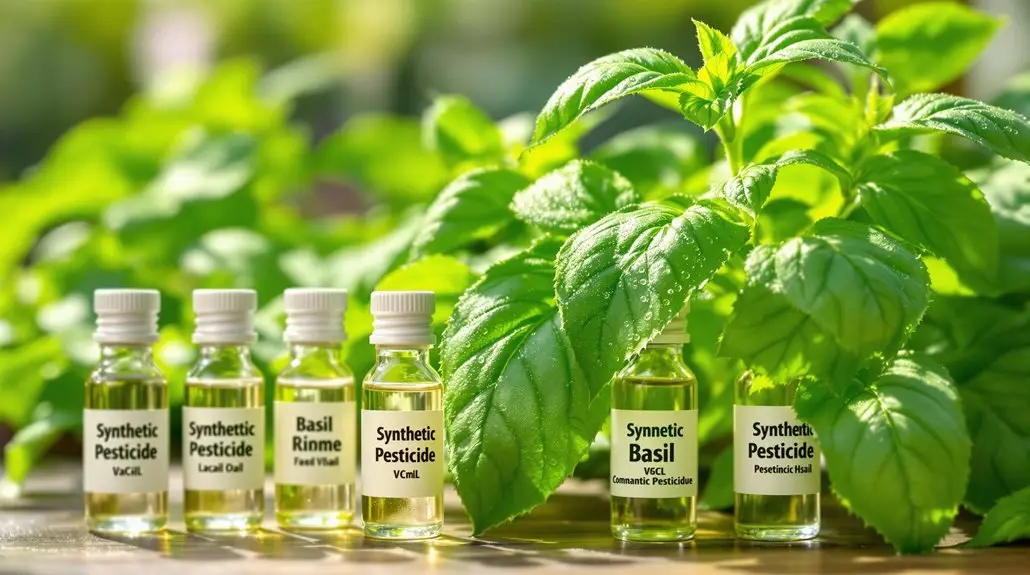
When you compare basil extracts to synthetic pesticides, you’ll notice differences in efficacy against pests. While basil shows promising results with certain insects, synthetic options often deliver faster and broader pest control. However, the security and environmental impact of basil extracts make them an attractive alternative worth considering. Additionally, the use of organic farming practices can further enhance the benefits of basil extracts by reducing reliance on harmful chemicals. Furthermore, the application of insecticide treatments has shown varying effectiveness in controlling pest populations, particularly with products like Beleaf 50SG.
Efficacy Against Pests
How effective is basil as a natural pesticide compared to synthetic options? You’ll be pleased to know that basil isn’t just a culinary herb; it’s a powerful ally against pests.
Research shows that basil oil outperforms some conventional pesticides, making it an excellent choice for eco-friendly pest control.
- Basil oil achieved 97% and 100% mortality against dust mites at just 3% and 4% concentrations.
- It shows higher efficacy than conventional acaricides like benzyl benzoate and permethrin.
- Essential oils from basil can kill mosquito larvae with an LC50 of 58 mg/L.
- Basil’s natural compounds, like linalool, provide strong repellency compared to synthetic insecticides.
- Using basil reduces the environmental pollution linked to synthetic pesticides. Additionally, its strategic placement in gardens promotes a three-angled defense against pests, enhancing its effectiveness.
Safety and Environmental Impact
Basil not only serves as an effective natural pesticide but also offers significant protection and environmental benefits compared to synthetic options. Unlike synthetic pesticides, which can harm the developing nervous system, basil’s natural compounds pose fewer risks to health and the environment. Its unique chemotypes, rich in beneficial compounds like linalool, contribute to its effectiveness while promoting security. Additionally, using basil-derived pesticides helps reduce exposure to harmful pesticide residues in conventional crops, which is a growing concern for consumer health. Furthermore, studies show that pesticides penetrate live leaves more rapidly, allowing for effective pest management strategies.
| Aspect | Basil Pesticides |
|---|---|
| Environmental Impact | Minimizes pollution compared to synthetics |
| Safety Profile | Generally safer; specific handling needed |
Using basil in integrated pest management can help reduce reliance on synthetic pesticides. While some basil compounds, like methyl eugenol, require careful handling, the overall profile shows promise without the long-term environmental consequences of synthetic options. Additionally, basil leaf structures allow for efficient pesticide removal, making it a preferable choice in sustainable farming practices. By choosing basil-derived pesticides, you’re not just protecting your plants; you’re also nurturing the environment and promoting a healthier ecosystem for everyone.
Future Research Directions
As research into the pesticidal composition of basil continues to evolve, exploring the myriad bioactive compounds within various basil varieties is crucial.
To truly harness the power of basil in pest management, several future research directions could notably enhance our understanding and application of these compounds.
Consider focusing your efforts on the following areas:
- Chemical Diversity: Investigate the chemical diversity of basil varieties to identify novel bioactive compounds with pesticidal activity.
- Nanoparticle Formulations: Develop nanoparticle formulations of basil-derived compounds for enhanced pesticidal efficacy and environmental sustainability. This includes exploring the potential of nanoinsecticides to improve the delivery and effectiveness of these bioactive compounds.
- Environmental Impact: Assess the environmental impact of basil-derived pesticidal compounds on non-target organisms and ecosystems, especially given the antimicrobial properties of essential oils such as linalool.
- Combination Therapies: Investigate the efficacy of combining basil-derived pesticidal compounds with other Integrated Pest Management (IPM) strategies.
- Toxicity Studies: Conduct toxicity studies to verify the reliability of basil-derived pesticidal compounds for humans and non-target organisms.
Frequently Asked Questions
Can Basil Oil Be Used in Organic Farming Practices?
Absolutely, you can use basil oil in organic farming practices! Its natural properties make it a fantastic option for pest control.
By incorporating basil oil, you not only protect your crops but also contribute to a healthier environment. Plus, it aligns perfectly with sustainable farming methods.
You’ll find that basil oil can enhance your farming experience while keeping things eco-friendly. So, if you’re looking to go green, basil oil’s the way to go!
Are There Any Known Side Effects of Basil Oil on Humans?
Have you ever wondered about the side effects of basil oil on your health?
While basil oil’s aroma can be delightful, it’s important to know it may cause allergic reactions or exacerbate bleeding disorders. If you have low blood pressure, it could be risky too.
Plus, using it during pregnancy isn’t recommended. Always use basil oil sparingly and consult a healthcare professional to guarantee it fits securely into your wellness routine.
How Can Basil Oil Be Extracted at Home?
To extract basil oil at home, start by freezing fresh basil for 24 hours.
Chop 100 grams of the basil leaves and mix it with water at a ½:1 ratio.
Use a blender to grind the mixture, then set up your distillation kit according to the instructions.
Combine the basil mixture in the kit, distill it, and separate the oil from the hydrosol.
What Is the Shelf Life of Basil Oil as a Pesticide?
The shelf life of basil oil as a pesticide typically ranges from six months to a year, depending on storage conditions.
You’ll want to keep it in an airtight container, away from sunlight and heat, to maintain its potency.
Refrigeration can also help extend its life, though the oil may cloud up in the cold, which is completely normal.
Proper care guarantees you get the most out of your basil oil for pest control.
Can Basil Oil Harm Beneficial Insects in Gardens?
Imagine you’re in a garden party, enjoying the fresh smell of basil.
But beware, basil oil can indeed harm beneficial insects like bees and butterflies if used carelessly. While it’s more natural than synthetic pesticides, high concentrations can be toxic.
To keep your garden buzzing with life, apply basil oil thoughtfully—targeted methods and lower concentrations help protect those friendly pollinators.
Contact NaturePest Today
Basil is not only a culinary treasure but also a formidable ally in the battle against pests. With its natural acaricidal, insecticidal, and larvicidal properties, it presents a green alternative to synthetic pesticides. Picture a flourishing garden, free from harmful chemicals, permeated with the delightful aroma of basil—a true testament to nature’s bounty. As research progresses, we eagerly anticipate tapping into this herb’s full potential for a healthier planet.
Join us at NaturePest Holistic Pest Control, where we believe in harnessing the power of nature for effective pest management. Together, let’s embrace the benefits of basil and create a pest-free environment that is safe for you and the planet. Make the switch today and experience the beauty of a garden thriving naturally!

